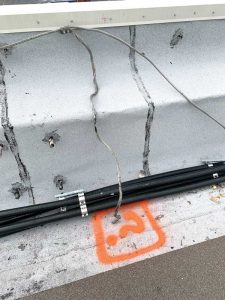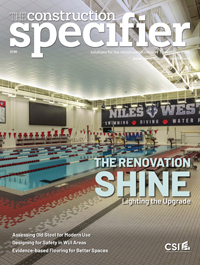Dissecting code language updates to lightning protection systems
-

The integration of lightning protection systems (LPS) and roofing systems often leads to questions surrounding penetrations and sequencing. Lightning rods are required to be installed around the perimeter at 6 m (20 ft) intervals. It is not just the corners this proposal would compromise. Depending on the width of the coping, every lightning rod could be affected.
NFPA 780 Section 4.7.2.2 states “Strike termination devices shall be placed on ridges or pitched roofs and around the perimeter of flat or gently sloping roofs at intervals not exceeding 20 ft.” Similar language is provided in UL 96A, Section 8.2.2.1.
- Lightning protection conductors are required to be attached every 0.9 m (3 ft) maximum. This creates a problem all to itself. If the conductors are fastened to the membrane, it will create many holes in the membrane. If the assembly requires brackets, it will require many brackets, making it problematic to coordinate the exact layout, timing, warranty, etc.
NFPA 780 Section 4.10, “Conductor Fastener. Conductors shall be fastened to the structure upon which they are placed at intervals not exceeding 3 ft.” Similar language is provided in UL 96A, Section 9.1.5.
Building consensus
The next step was to generate new language and submit it for public comment. Over the course of the next several months, SPRI reached out to several other industry organizations for meetings and discussions about this issue. Meetings were held with representatives from UL Solutions, LPI, the United Lightning Protection Association (ULPA), the National Roofing Contractors Association (NRCA), the Asphalt Roofing Manufacturers Association (ARMA), the Roof Coating Manufacturers Association (RCMA), the NEMA, and others to come to consensus on a public comment revising the language from what was originally proposed.
After several months of discussions and meetings, new draft language was developed jointly by SPRI and the lightning protection industry with assistance from UL Solutions, RCMA, NRCA, ARMA, NEMA and others, and submitted for public comment. In the fall of 2022, the ICC public comment hearings were held. During the meeting, the public comment language was approved by two-thirds of the ICC Governmental Voting Membership and ratified via
a subsequent online vote, thereby solidifying the new language, provided below, which will be published in the 2024 edition. The IBC is due out in the fall of 2023 and will then be ready for adoption by states and jurisdictions across the U.S. and internationally.
During the public comment hearing, representatives from National Association of Home Builders (NAHB), the United Lightning Protection Association (ULPA), UL Solutions and others spoke in favor of the modified language, which addressed earlier concerns of the lightning and home building industries.








